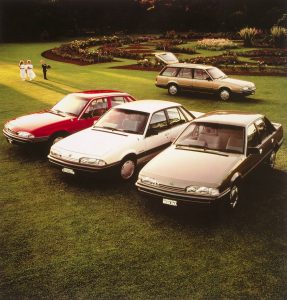Recalls: Holden VL Commodore
Overview
Manufacturers, or importers, issue recalls for defects or faults which have the potential to cause injury. Generally, manufacturers will inform the original buyers if their vehicle is subject to a recall and of the steps required to remedy the defect or fault. Please note that the recalls below (if any) are for Australian-delivered vehicles only. Furthermore, the number of recalls should not be taken as an indication of a model’s reliability or its safety more generally.
Recalls: Holden VL Commodore
- In November 1986, a recall was issued for Holden VL Commodore vehicles with six cylinder engines that were manufactured between February and October 1986. In these vehicles, chafing of electrical wiring could cause a short circuit – this could pose a potential fire hazard (PRA 1986/0077).
- In January 1987, a recall was issued for VL Commodore vehicles that were manufactured between August 1986 and February 1987. In these vehicles, the tie-rod housing may detach from the steering rack, resulting in a partial loss of steering (PRA 1987/0105).
- In October 1987, a recall was issued for Holden VL Commodore vehicles due to a possible defect in the Iso-vac Booster (PRA 1987/0281).
- In July 1988, a recall was issued for VL Commodore vehicles due to incorrectly manufactured steering knuckles (IDs J145736 to J153237) which could result in reduced steering control (PRA 1988/0468).
Problems and faults: Holden VL Commodore
Overview
This section identifies potential problems, causes and fixes based on the experiences of owners and repairers, online sources and technical service bulletins. This information is provided solely for reference purposes and AustralianCar.Reviews recommends that only properly qualified persons carry out repairs or modifications. Furthermore, the number of items below should not be taken as an indicator of a model’s reliability or the frequency with which they may occur.
To report a problem or fault to the AustralianCar.Reviews team, please use the Contact Us form. Note that AustralianCar.Reviews does not offer advice on automotive problems or disputes; such enquiries will not receive a reply. For vehicles purchased from dealers after 1 January 2011, please see our Australian Consumer Law fact sheet.
RB30E Engines
- The distributor contains a crank angle sensor which, if it fails, will result in the engine not starting. Furthermore, if the rubber boot which insulates the wiring connector perishes, the connector can fail due to moisture ingress – this also prevents the engine from starting.
- The cross-flow radiators have a separator plate in the middle of the right tank. Although soldered in position, if the separator plate is dislodged and falls to the bottom of the tank, coolant may flow through the right tank but not through the core where it can be effectively cooled – this can result in overheating.
- The cast iron exhaust manifold is bolted to the alloy head by 12 studs and nuts. Because iron and the alloy have different coefficients of expansion, stress is placed on the studs which can eventually break and blow out the manifold gasket. Broken studs and exhaust leaks are most common on # 6 exhaust port. If broken, the studs usually need to be drilled out and tapped for new studs to be fitted. It is also recommended that the face of the exhaust manifold be machined flat to ensure adequate sealing when replaced.
- The front engine exhaust pipe bolts to the exhaust manifold. Over time, the flange gasket surface of the engine pipe can warp, reducing the clamping force on the flange gasket – this can cause the exhaust flange gasket to fail and the exhaust to leak. If so, the front engine pipe needs to be replaced.
V8 Engines
- The alloy intake manifolds are susceptible to corrosion around the four water port faces and the thermostat housing. Furthermore, the manifold faces may also warp around the EGR (Exhaust Gas Recirculation) ports because of the hot exhaust gases crossing under the manifold – if this occurs, oil may pool in the middle of each side of the manifold below the carburettor.
- Diaphragms are bolted to the distributor which advance engine timing during acceleration. These diaphragms, however, can split – resulting in a loss of power – and can be difficult to source.
- Harmonic balancers usually consist of inner and outer hemispheres which dissipate energy through vulcanized rubber. Over time, the rubber perishes or loosens and the outer hemisphere can move freely of the inner hemisphere. This can cause damage to other parts and a loss of timing position.
- The rear main seal is made from rope which squeezes against the crankshaft at the rear of the engine. Hot engine oil and age reduces the seals ability to work effectively, resulting in oil leaks from the back of the crankshaft. To replace the seal, the crank needs to be removed from the engine – this generally requires that the engine also be removed.
- An exhaust preheat butterfly valve – positioned between the right hand exhaust manifold and front engine pipe – can seize. If the valve seizes in the closed position, engine power can be significantly reduced. The housing of the valve may also crack, creating an exhaust leak that can also result in power loss.
- Many early V8 engines did not have an external fuel filter fitted (instead relying on the fuel tank sender unit sock to trap dirt particles). As such, an external, replaceable filter should be fitted.
Electrical
- For the tail lights, poor electrical earth connections can result in erratic lamp operation – this can be fixed by soldering a fresh earth to the tail lamp wiring loom.
- Indicator stalks are a common failure item since the steel plate breaks away from the cast metal.
- The air mass meter uses a hot wire to register the amount of air entering the engine intake; backfiring can damage this hotwire and prevent the engine from starting. The internal electrical components of the air flow meter can also fail.
- Excessive fuel consumption can occur if the temperature sender unit fails (sending the wrong voltage to the ECU).
- Plastic fuse rails can melt from excessive current draw. Although fuse rails can be replaced, installing relays may reduce the current draw through the fuse rail.
Steering
- Steering rack leaks are common, either from the rack ends (which fill up the dust boots) or from the top hub seal.
Interior
- The main odometer drive cog is cast alloy and pressed onto a hardened steel shaft. If the cast alloy drive cog wears and no longer grips the steel shaft, the odometer stops working.
- The speedometer relies on a gear on the end of a cable meshing with a gear on the output shaft of the gear. If either gear is stripped, the speedometer will stop working. Alternatively, the output shaft gear may be slipping or have slipped down the shaft.
- The seat mountings where the driver’s seat bolts to the floor can crack – this can result in the seat moving beyond acceptable limits.




